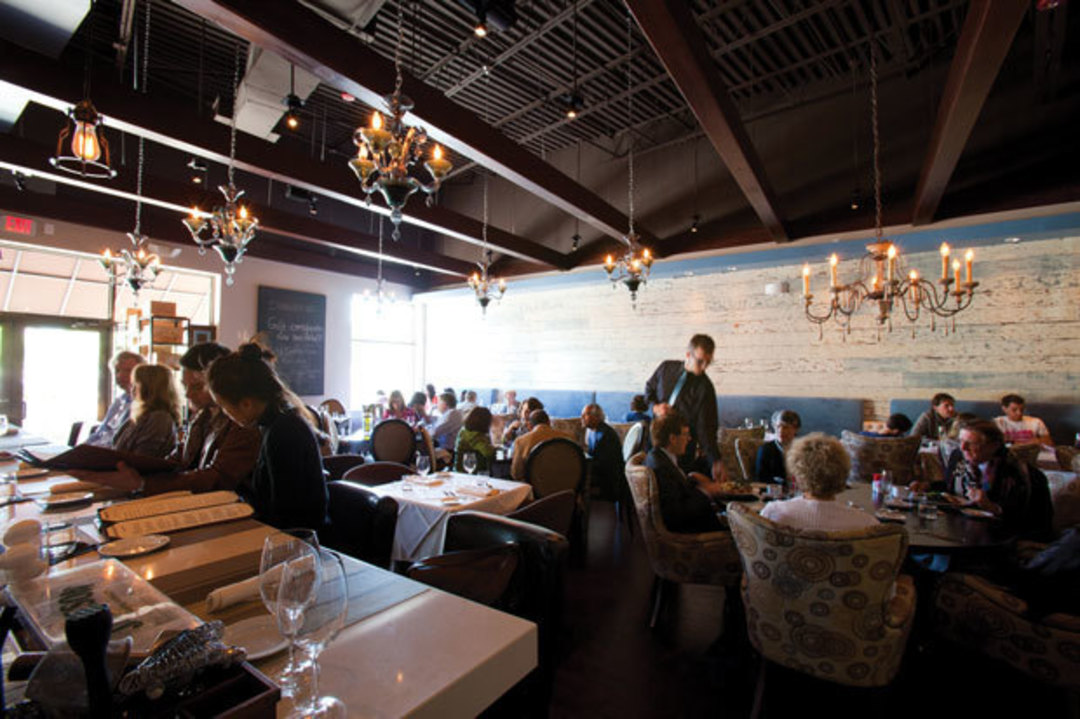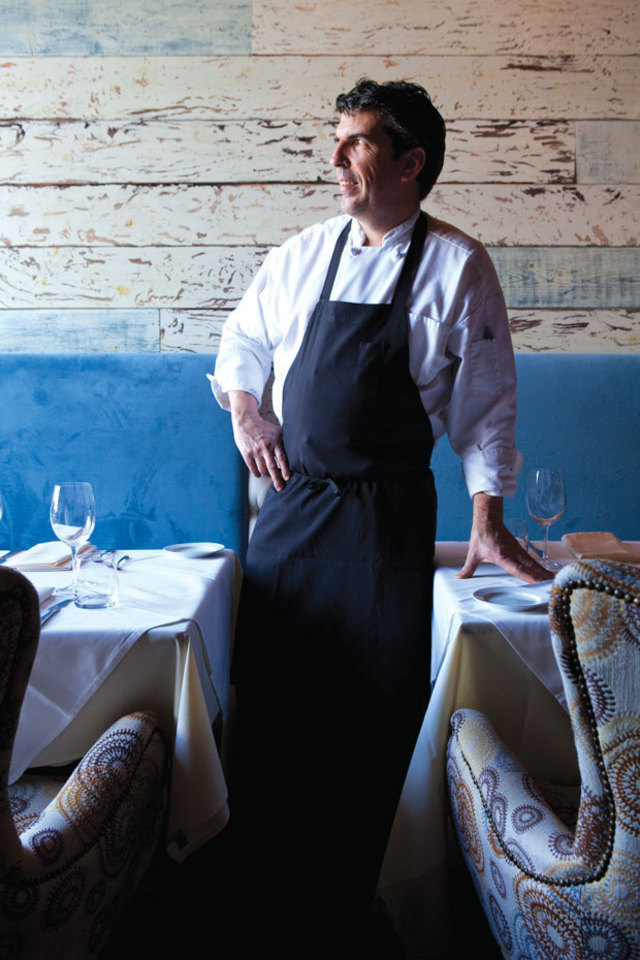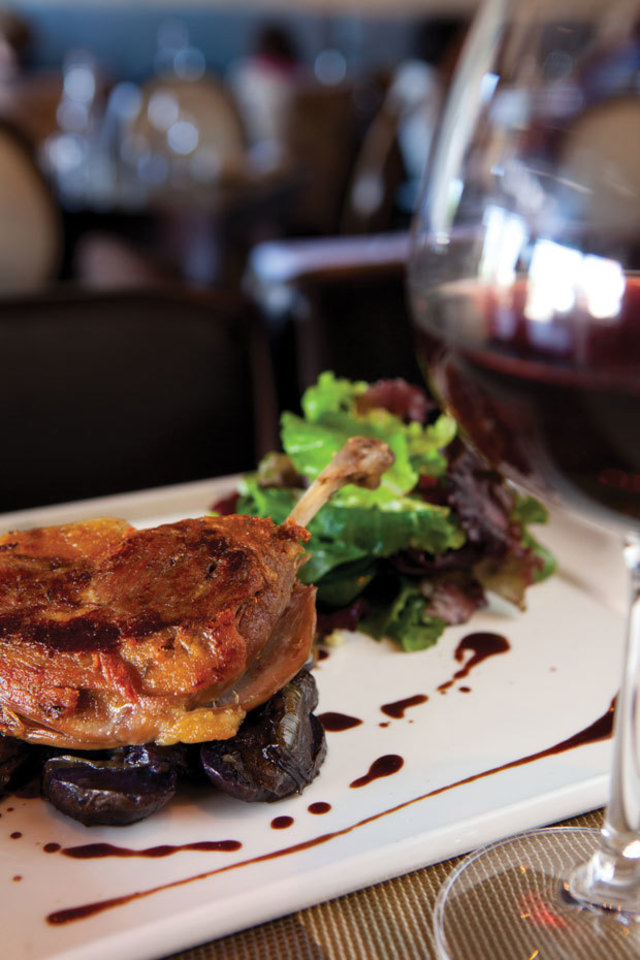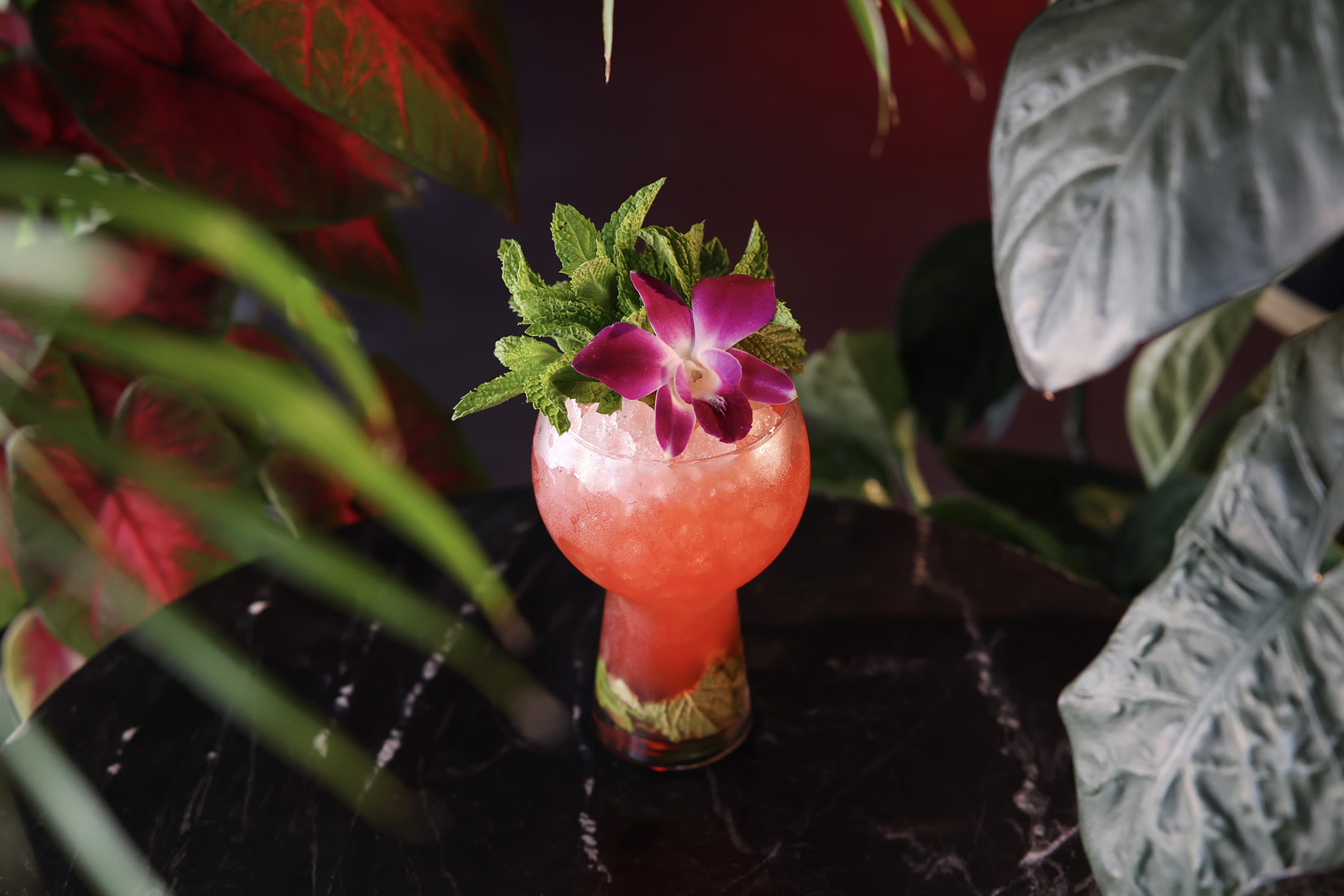Shooting Star

Best feature of Étoile’s dining room? Comfortable chairs.
Image: Shannon O'Hara
On my first visit to Étoile Cuisine et Bar, the popular new French restaurant in Uptown Park, I did a lunchtime retake of the first scene in Julie and Julia. I ordered the hearty duck leg confit, which came with soft purple fingerling potatoes, caramelized onions, and fresh salad greens—all of which combined to turn a chunk of dark duck meat into an intriguing dish. My wife got the delicate lemon sole meunièreserved with the same potatoes and crispy snow peas.
The scene I’m referring to, which begins while the opening credits are still rolling, is a reenactment of Julia Child’s moment of culinary awakening over a lunch of sole meunière shortly after her arrival in France. Meryl Streep, playing Julia Child, emits a long series of enthusiastic noises to signal her delight and astonishment at the flavor of the fish while lovingly feeding a forkful to Stanley Tucci, who plays Julia’s husband, Paul.

Will this sole meunière change your life?
Image: Shannon O'Hara
My wife didn’t exactly feed me, but she did kindly shove her plate my way so I could sample some. Like the fish that Julia Child ate on that day in 1948, the flavor of the sole meunière at Étoile was such a surprise, its lemon butter and caper sauce so bright and enthralling, I could barely stop myself from inhaling the entire portion.
Fish in meunière sauce is a standard in Gulf Coast Creole cuisine—and that’s why the sole meunière at Étoile is such a revelation. It doesn’t taste anything like the Creole version. At Galatoire’s in New Orleans, the fish is dipped in egg and flour to create a thick crust, and the “meunière butter” is made in advance in large batches using a very dark, burnt butter beurre noir and white wine.
At Étoile, chef/owner Philippe Verpiand returns the dish to its origins. Literally, meunière means “the miller’s wife,” and refers to the flour in which the sole is dipped before being gently cooked in butter. In the original version, the sauce is made à la minute by adding a little lemon juice to the lightly browned flour in the buttery pan. A few salty capers and a little chopped parsley are added to finish the startlingly simple sauce.
There weren’t any purple fingerling potatoes or crispy snow peas on the plate when Julia Child ate her fateful lunch. In classic French restaurants, the entrée is served alone—that’s why they call everything else side dishes. At Étoile, Verpiand presents a modernized version of classic French food that artfully combines vibrant vegetables with the plat principal—a style he perfected while cooking under Chef Jean-Michel Diot. Lured to sunny Southern California at the peak of the economic boom, Verpiand served as chef de cuisine at Tapenade Restaurant in La Jolla under Diot, who had embraced the farm-to-market movement, combining French classics with local organic vegetables.
Verpiand later opened his own restaurant outside San Diego, but when the economic downturn of 2008 popped the real estate bubble and shook the SoCal economy, the chef was reduced to offering coupons to get people in the door. On a 2009 trip to Houston, where his wife has family, Verpiand was awestruck to find every restaurant he visited packed. And so last fall, he relocated to Houston and opened Étoile in Uptown Park.

Chef Philippe Verpiand is glad he came to Houston.
Image: Shannon O'Hara
Chef Philippe Verpiand was born in the village of Cavaillon in Provence. His father was a butcher, and so was his grandfather. After graduation from the French Culinary Institute in Avignon, Verpiand entered the French apprenticeship system, working in a series of Michelin-starred restaurants across France and gleaning a little knowledge and experience from each.
Over two of three meals at Étoile—that lunch with my wife, and a dinner—I witnessed a masterful display of Verpiand’s slightly Americanized classic French cooking. On one side of the menu, under the heading “La Tradition,” there are time-honored classic appetizers such as escargot, lobster bisque, and moules marinières, as well as plats principaux including coq au vin, steak frites, and that sole meunière. The other side of the menu, “La Saison,” features a selection of seasonal offerings that changes according to what’s in the markets. The best dishes reflect the chef’s upbringing in the south of France.
At dinner with my wife and another couple, I sampled the retour de pêche, or catch of the day, from the La Saison entrées, a sea bass cooked perfectly with crispy skin and served on top of a brilliant Provençale mélange of grilled eggplant, zucchini ratatouille, olive tapenade, and the roasted sweet Spanish peppers called pimiento del piquillo. The coquilles Saint-Jacques à la Provençale, a traditional appetizer, was made with giant sea scallops sautéed with mildly anise-scented fennel, sweetened with a house-made tomato marmalade, and spiked with black olives. It was terrific.
From the seasonal menu, we tried the rich and satisfying calamars à la Basquaise appetizer, a Basque-style stew popular on the Southwestern Atlantic coast of France, made with tender calamari and sautéed shrimp in a bowl of creamy but firm risotto-like “paella rice.” Another Basque favorite, les moules Saint Jean de Luz, named after the port city on the Atlantic coast, is a bowl of mussels cooked in a cream sauce with Spanish chorizo, leeks, and the hottest chile pepper used in French cooking, piment d’Espelette. You can order the mussels as an appetizer or with French fries as a main course, which is what we did. We went through an extra basket of bread trying to sop up the spicy cream sauce left in the bottom of the bowl—it’s the best part.
The most unique dish that night at Étoile was a seasonal appetizer called tarte à la fourme d’Ambert, a crispy pastry round with creamy fourme d’Ambert blue cheese oozing through the crust, topped with dark red triangles of pear poached in red wine and served with an arugula salad on the side. The combination of warm pastry, mild blue cheese, and salad was spectacular, and it was the only dish on the menu that I hadn’t seen before.
“It’s my own creation,” chef Verpiand admitted, but he didn’t think it was very original. “Salad and quiche are very nice together, this is the same idea. It’s the cheese that makes the dish special.”

Hearty duck confit on purple potatoes with salad greens at Étoile
Image: Shannon O'Hara
Fourme d’Ambert is one of the oldest cheeses in France, dating back to Roman times. Made in a log shape, the cow’s milk cheese stays light and creamy because the curds aren’t pressed. When aged, it develops an earthy flavor and turns yellow. Verpiand once lived in Auvergne, where fourme d’Ambert comes from, and he’s a fan, also featuring it on Étoile’s cheese plate, along with brie, goat cheese, and a subtle artisanal sheep’s milk cheese called P’tit Basque.
The third meal we had at Étoile was brunch, which isn’t a traditional French meal, although it has become popular in Paris in the last decade. Sadly, the croissants were not very flaky, the beignets were disappointingly hollow, and the brioche was just overpriced toast. The tomato omelet, with tomato marmalade, black olives, and fresh herbs, sounded more impressive than it tasted.
A wild boar Bolognese (also offered at lunch) suffered from dry, woody meat chunks in the Bolognese. The bright red meat sauce crowned a bowl of pasta tossed with an inedibly salty cream sauce. I like my food salty, but not this salty, so I sent it back. It returned a little better, but not by much. My only other disappointment was the coq au vin, which is offered on the brunch menu, although I’d tried it at dinner. The poultry was dry and chalky.
The dining room at Étoile is sunny and handsome, with one wall of salvaged wood planks sanded down to show several colorful layers of paint. There are two rows of white-linen-covered tables, with a row of bare wood tables in between. All the chairs are comfortable, but some, the upholstered armchairs, are extremely so. The service is competent without being fawning.
Verpiand told me he was delighted with his new hometown. “There is an energy here that is missing in San Diego,” he said. “Houston is booming.” Local movers and shakers seem to love Étoile, and it’s probably because the staff doesn’t make much of a fuss over anybody.
The relaxed atmosphere follows the lead set by chef Verpiand. Coming from a family of culinary craftsmen, he does his job expertly and without fanfare. Rather shy, with a thick French accent, he doesn’t visit with diners at their tables very often, and he doesn’t seem interested in becoming the city’s next celebrity chef. The restaurant feels like a comfortable institution, despite the fact that it’s only six months old.
A great French restaurant is a cornerstone of any fine-dining scene, but lately ours have been trying too hard to dazzle us with cutting-edge interior design and celebrity-chef shtick. Étoile has become one of the city’s top stars simply by sticking to the basics.




